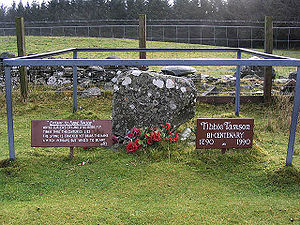
Tibbie Tamson
Encyclopedia

Scotland
Scotland is a country that is part of the United Kingdom. Occupying the northern third of the island of Great Britain, it shares a border with England to the south and is bounded by the North Sea to the east, the Atlantic Ocean to the north and west, and the North Channel and Irish Sea to the...
woman, who lived in Selkirk, in the Scottish Borders
Scottish Borders
The Scottish Borders is one of 32 local government council areas of Scotland. It is bordered by Dumfries and Galloway in the west, South Lanarkshire and West Lothian in the north west, City of Edinburgh, East Lothian, Midlothian to the north; and the non-metropolitan counties of Northumberland...
, in the 18th century. Her grave is located on a hillside, around 1.5 miles north of Selkirk, at . While Tamson certainly did exist, and is recorded as dying in 1790, few facts are known about her. Historic Scotland
Historic Scotland
Historic Scotland is an executive agency of the Scottish Government, responsible for historic monuments in Scotland.-Role:As its website states:...
recognise her existence. Each year, members of the Selkirk Common Riding
Common Riding
Common Riding is an annual event celebrated in Scottish Border towns and in some other places, to commemorate the times of the past when local men risked their lives in order to protect their town and people.- Hawick :...
Organisation place a wreath in remembrance of her.
Several different stories surround Tibbie Tamson, which attempt to explain why she was buried in such an isolated spot. The four most prevalent theories are:
- she was executed for witchcraftWitchcraftWitchcraft, in historical, anthropological, religious, and mythological contexts, is the alleged use of supernatural or magical powers. A witch is a practitioner of witchcraft...
; - she committed suicideSuicideSuicide is the act of intentionally causing one's own death. Suicide is often committed out of despair or attributed to some underlying mental disorder, such as depression, bipolar disorder, schizophrenia, alcoholism, or drug abuse...
and was denied Christian burial; - she was a victim of plague;
- she was a victim of murderMurderMurder is the unlawful killing, with malice aforethought, of another human being, and generally this state of mind distinguishes murder from other forms of unlawful homicide...
.
The execution theory
It is debated that Tibbie Tamson was an executed criminal, found guilty of witchcraftWitchcraft
Witchcraft, in historical, anthropological, religious, and mythological contexts, is the alleged use of supernatural or magical powers. A witch is a practitioner of witchcraft...
and sentenced to death by being burnt at the stake. This theory states that, owing to her unholy activities, her body was buried outside the town as was the legal custom. If this is true, this would explain her being buried close to, but not in, the neighbouring town of Philiphaugh, as well as outside Selkirk. Most people in Selkirk tend to hold this position although, it could be a confusion with a certain Megan Lawson who was recorded by the Scottish courts as being executed by strangulation and burned for being an alleged witch in Selkirk's town square around the same time. Some reject Tibbie Tamson as being executed for witchcraft because of its implications for the town's history.
The suicide theory
This theory is the one preferred by Historic Scotland. The theory states that she was mentally and/or intellectually challenged. Due to this she would have been tormented and treated with contempt in her community. When Tibbie stole a piece of yarn, she was summoned to the sheriff courtSheriff Court
Sheriff courts provide the local court service in Scotland, with each court serving a sheriff court district within a sheriffdom.Sheriff courts deal with a myriad of legal procedures which include:*Solemn and Summary Criminal cases...
to face trial. When found guilty of this petty offence, which she did not fully understand, she would have been taunted and tormented even more. This seems to have been the tipping point where due to embarrassment, she is said to have gone home and hanged herself.
Suicide not being tolerated or looked upon compassionately at that time, she would have been posthumously punished by the Scottish courts by being buried in non-consecrated ground outside the town.
When a servant of the local landowner, the Duke of Buccleuch
Duke of Buccleuch
The title Duke of Buccleuch , formerly also spelt Duke of Buccleugh, was created in the Peerage of Scotland on 20 April 1663 for the Duke of Monmouth, who was the eldest illegitimate son of Charles II of Scotland, England, and Ireland and who had married Anne Scott, 4th Countess of Buccleuch.Anne...
, a Mr. Michael Stewart, dug up her grave in an effort to give her a dignified interment, he found the body was clothed, and had a penny and a farthing inside her pocket. He later reburied her, with a small Christian ceremony, and laid a crude headstone on her place of burial which can still be seen today. All this suggests that she could not have been burned.
It is also worthy of note that Mr. Stewart mentions her body was refused interment in the 'Auld Kirk yard', and turned over to the Selkirk Burgh constable to be placed outside the town for the crime of "self murder". This was said to have been reported by Mr. Stewart approximately 90 years after her ordeal. If this is true it may be very reliable evidence from a potential eye witness, however Mr. Stewart would be one hundred years old if he did witness it when he reported it, this is highly unlikely but cannot be fully dismissed on grounds that it is not impossible.

